Arctic Travel
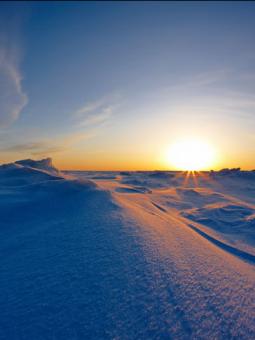
The Arctic is a polar region located at the northernmost part of the Earth. It encompasses the Arctic Ocean and parts of several countries, including Canada, Russia, the United States (Alaska), Norway, Greenland (an autonomous territory of Denmark), Iceland, Sweden, Finland, and a few others. The Arctic is a captivating and fragile region that holds immense ecological, cultural, and scientific importance. It serves as a barometer for global climate change and calls for responsible stewardship to preserve its unique environment and support the livelihoods of those who call it home. Climate and Geography: The Arctic is characterized by its extreme cold temperatures and long, harsh winters. It is covered by ice for most of the year, with the Arctic Ocean’s sea ice expanding during winter and shrinking during summer. The region is also known for the phenomenon of the midnight sun, where the sun remains visible for 24 hours during the summer solstice and the polar night during winter when the sun does not rise above the horizon.
Arctic Wildlife: The Arctic is home to a diverse range of wildlife, both on land and in the ocean. Iconic species include polar bears, Arctic foxes, reindeer, walruses, seals, whales (such as belugas and narwhals), and a variety of bird species. These animals have adapted to the extreme cold and rely on the Arctic’s unique ecosystem for their survival.
Indigenous Cultures of the Arctic: The Arctic is home to several indigenous communities who have inhabited the region for thousands of years. These communities, including the Inuit, Yupik, Saami, and others, have developed rich cultural traditions, subsistence practices, and knowledge of the Arctic environment. They have a deep connection to the land and rely on its resources for their livelihoods.
Arctic Melting Sea Ice and Climate Change: The Arctic has been experiencing rapid environmental changes due to climate change. Rising temperatures have caused the melting of sea ice, resulting in shrinking ice coverage and thinning ice sheets. This has significant implications for wildlife, indigenous communities, and global climate patterns.
Arctic Natural Resources and Exploration: The Arctic is rich in natural resources such as oil, gas, minerals, and fish stocks. As the ice melts, there has been increased interest in resource extraction and shipping routes through the region, leading to discussions about environmental impacts and sustainable development.
Inside Passage Travel
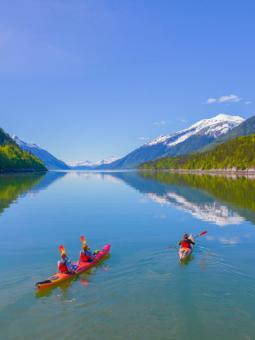
Inside Passage
The Inside Passage in Alaska is a breathtaking coastal route that stretches over 1,000 miles (1,600 kilometers) along the southeastern coast of Alaska, from the northernmost point of the state to the southern border with Canada. It is renowned for its stunning natural beauty, abundant wildlife, and opportunities for adventure and exploration. The Alaska Inside Passage is a remarkable destination that showcases the beauty and diversity of Alaska’s coastal landscapes. Its stunning scenery, abundant wildlife, and opportunities for outdoor adventure make it a must-visit for nature lovers and those seeking a unique and unforgettable travel experience. Geography and Location: The Inside Passage is a network of waterways, fjords, and islands that meander through the Alexander Archipelago, a group of more than 1,000 islands along Alaska’s coastline. It begins near the city of Skagway in the north and extends southward through towns such as Juneau, Sitka, Ketchikan, and finally reaching the southern border near Prince Rupert, British Columbia, Canada.
Scenic Beauty of the Inside Passage: The Inside Passage is famous for its breathtaking scenery. Towering mountains, pristine forests, glaciers, and deep blue fjords create a stunning backdrop for travelers. The region is also dotted with numerous islands and islets, adding to its beauty and providing sheltered waters for exploration.
Wildlife in the Inside Passage: The Inside Passage is teeming with wildlife. Visitors have the opportunity to spot humpback whales, orcas, sea lions, seals, sea otters, bald eagles, and a variety of bird species. The rich marine environment and coastal habitats make it an ideal destination for nature enthusiasts and photographers.
Inside Passage Glaciers: The Inside Passage is home to numerous glaciers, which are among the region’s most awe-inspiring attractions. Glacier Bay National Park and Preserve, located along the passage, is a UNESCO World Heritage Site and offers opportunities to witness calving glaciers, explore icy fjords, and learn about glacial processes.
Indigenous Cultures in the Inside Passage: The Inside Passage is historically and culturally significant, with a rich heritage of indigenous peoples. Native Alaskan tribes, including the Tlingit, Haida, and Tsimshian, have inhabited the region for thousands of years and continue to maintain their unique cultures, art, and traditions.
Travel to Denali National Park
One of the famous and most popular places to visit in Alaska is the Denali National Park. Home to the iconic and towering peak of 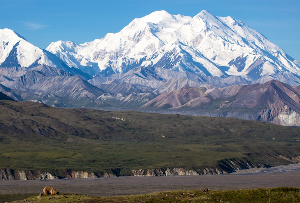 Denali (also known as Mount McKinley), which is the country’s highest mountain, Denali National Park is a protected wilderness area where all kind of wildlife can be seen. Spot bears, moose, wolves and more while walking along the Savage River, admiring the stillness of Wonder Lake or hiking through Polychrome Pass.
Denali (also known as Mount McKinley), which is the country’s highest mountain, Denali National Park is a protected wilderness area where all kind of wildlife can be seen. Spot bears, moose, wolves and more while walking along the Savage River, admiring the stillness of Wonder Lake or hiking through Polychrome Pass.
Hiking, whitewater rafting and back-country camping are popular ways to explore the national park, but there are also bus tours for a climate-controlled and safer way to get around. Short, ranger-led trail walks are available from the Denali Visitor Center, where you’ll also find informative and educational exhibits.
Katmai National Park Travel
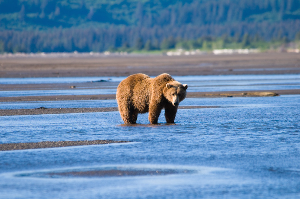
Katmai National Park is a vast and remote wilderness area located in southern Alaska, United States. The park is renowned for its stunning landscapes, diverse wildlife, and the world-famous Brooks Falls, where visitors can witness the annual salmon migration and grizzly bear feeding frenzy. Katmai National Park is a haven for nature lovers, wildlife enthusiasts, and outdoor adventurers. Its remarkable landscapes, incredible wildlife viewing opportunities, and commitment to conservation make it a destination that showcases the best of Alaska’s natural wonders.
Kenai Fjords National Park Travel
Visiting the Kenai Fjords National Park is like stepping back in time to the ice 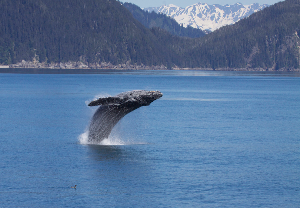 age. Glaciers and ice caps still exist and touch the edge of the ocean, creating dramatic and unforgettable views.
age. Glaciers and ice caps still exist and touch the edge of the ocean, creating dramatic and unforgettable views.
Half of the park is covered in ice year-round, and there are deep fjords that have resulted where the water valleys are formed. These fjords are the ideal home to a lot of aquatic wildlife, and you’ll easily spot migrating whales as well as birds swooping down to feed on the fish in the water.
Because of the icy conditions, many visitors choose to visit the Kenai Fjords National Park on a guided day tour, although there are limited accommodation choices in the park itself. Kenai Fjords National Park is a stunning wilderness area located in southern Alaska, USA. The park is renowned for its rugged coastline, icy fjords, towering glaciers, and abundant marine and terrestrial wildlife. Kenai Fjords National Park provides an awe-inspiring experience, showcasing the beauty and grandeur of Alaska’s coastal landscapes. Its glaciers, fjords, wildlife, and outdoor activities make it a must-visit destination for nature enthusiasts and those seeking an unforgettable Alaskan adventure.
Mendenhall Glacier Travel
Just a short drive from the city of Juneau is the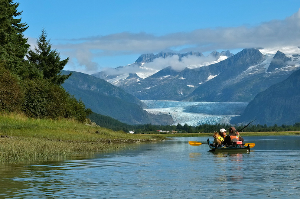 Mendenhall Glacier, an enormous glacier that is calving, or separating, into its own adjacent lake. There are a number of different ways to experience the glacier, ranging from a simple shuttle ride to see it up close or a helicopter ride to truly appreciate the sheer size of the glacier.
Mendenhall Glacier, an enormous glacier that is calving, or separating, into its own adjacent lake. There are a number of different ways to experience the glacier, ranging from a simple shuttle ride to see it up close or a helicopter ride to truly appreciate the sheer size of the glacier.
The fittest visitors may want to try out the Mendenhall Glacier West Glacier Trail, which is very challenging but provides incredible opportunities for photography. Also worth a visit is the Mendenhall Glacier Visitor Center, which includes exhibits about the glacier as well as several viewing platforms. Mendenhall Glacier is a natural wonder that offers a glimpse into the power and beauty of Alaska’s glaciers. With its accessibility from Juneau, visitors have the opportunity to witness firsthand the awe-inspiring landscape, engage in outdoor activities, and learn about the importance of preserving these icy giants for future generations.
Travel to Juneau
Just a short drive from the city of Juneau is the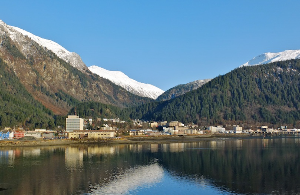 The capital city of Alaska is Juneau, which serves as a major port for cruise ships through the area. It is also home to major attractions such as the Alaska State Museum, the Alaska State Capitol and the incredibly serene Shrine of St Therese.
The capital city of Alaska is Juneau, which serves as a major port for cruise ships through the area. It is also home to major attractions such as the Alaska State Museum, the Alaska State Capitol and the incredibly serene Shrine of St Therese.
For excellent views over Juneau, ride on the Mount Roberts Tramway, and from the top set off on one of the many hiking trails overlooking the city. Juneau is also home to a number of breweries, and there are multiple companies offering brewery tours to warm you up on a cold day.
Head to Front Street for plenty of excellent souvenir shops and local restaurants where you can sample regional cuisine.
Travel to Anchorage
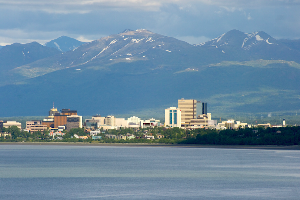 Although it isn’t the capital, Anchorage is the largest city in the state of Alaska. Almost half the state’s residents live in or around the city, as Anchorage serves as the economic heart of Alaska. It offers the comforts of a large US city but is only a 30-minute drive from the Alaskan wilderness.
Although it isn’t the capital, Anchorage is the largest city in the state of Alaska. Almost half the state’s residents live in or around the city, as Anchorage serves as the economic heart of Alaska. It offers the comforts of a large US city but is only a 30-minute drive from the Alaskan wilderness.
You may want to start your time in Anchorage by visiting the Anchorage Museum of History and Art, the Alaska Wildlife Conservation Center or the Alaska Native Heritage Center. Then, drive along the Seward Highway to Potter’s Marsh for incredible bird watching or set off on a hike along the Tony Knowles Coastal Trail.



